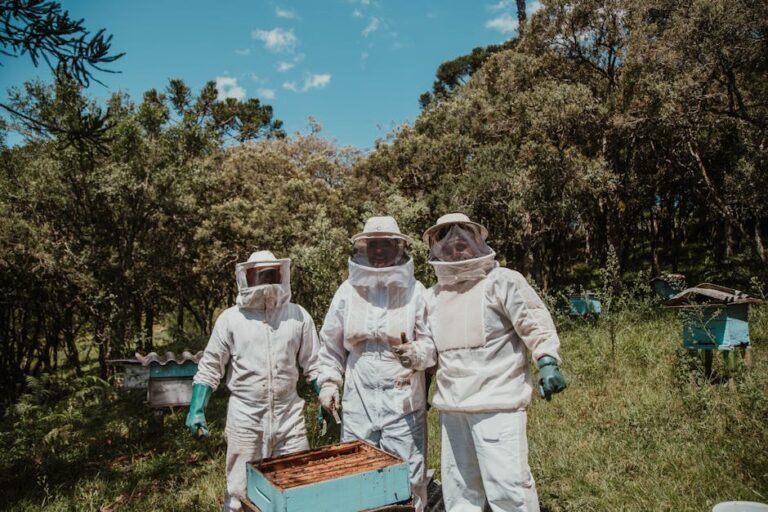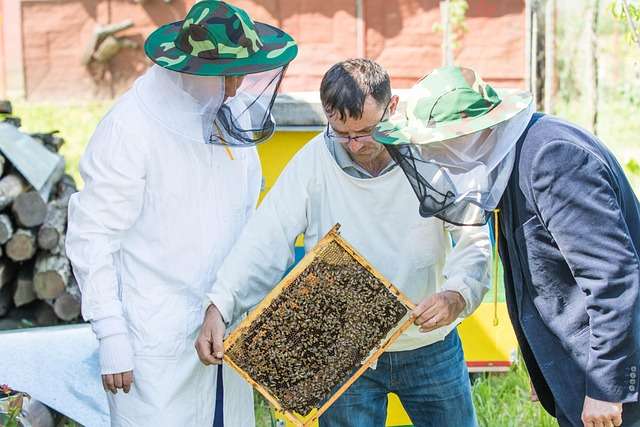Starting a local beekeeping club can be one of the most rewarding ways to build community, share knowledge, and support new and experienced beekeepers in your area. Here’s a comprehensive step-by-step guide based on successful club models and best practices.
Getting Started: Initial Planning
1. Define Your Club’s Purpose
Before anything else, establish clear goals for your club[1][2]. Common objectives include:
- Supporting local beekeepers with education and mentorship
- Promoting bee conservation and pollinator awareness
- Providing resources on best beekeeping practices
- Creating a social environment for learning and networking
- Offering hands-on training and seasonal guidance
- Building community connections around beekeeping
2. Gauge Interest and Find Members
Start by assessing local interest[3][2]:
- Post on social media: Use Facebook groups, Nextdoor, or community forums
- Contact existing networks: Reach out to gardening clubs, environmental groups, or farmers markets
- Visit local establishments: Post flyers at libraries, garden centers, co-ops, and coffee shops
- Check with extension services: County agricultural extension agents often know interested beekeepers
- Ask current beekeepers: Even solo beekeepers may know others interested in joining a group
Aim for at least 10-15 interested people before organizing your first meeting.
3. Choose Your Club Structure
Decide on the formality level[3][4]:
- Informal Group: Monthly café meetings with no formal structure
- Basic Club: Regular meetings with minimal organization
- Formal Association: Elected officers, bylaws, and structured activities
- Nonprofit Organization: 501(c)(3) status for grants and tax benefits
Organizational Structure
4. Establish Leadership Roles
For a well-functioning club, establish key positions[1][5]:
| Position | Responsibilities |
| President | Overall leadership, meeting facilitation, external representation |
| Vice President | Assist president, step in as needed, often handle programs |
| Secretary | Meeting minutes, correspondence, maintain records |
| Treasurer | Financial management, dues collection, budgeting |
| Membership Coordinator | New member recruitment and orientation |
| Education Coordinator | Program planning, workshops, seasonal training |
| Community Outreach Coordinator | Public relations, events, educational outreach |
5. Create Bylaws and Operating Guidelines
Develop basic governing documents[5][4]:
- Membership requirements and dues structure
- Meeting schedules and procedures
- Officer roles and election processes
- Financial policies and spending authority
- Code of conduct for members
- Conflict resolution procedures
Portland Urban Beekeepers provides an excellent template for club bylaws[5].
6. Find a Meeting Location
Secure a regular meeting space[3][6]:
- Community centers or libraries (often free for nonprofits)
- Churches or religious centers with meeting rooms
- Schools or colleges during evening hours
- Local businesses (feed stores, garden centers)
- Members’ homes (if space allows)
- Outdoor locations during good weather
Consider accessibility, parking, and audio/visual capabilities.
Financial Management
7. Establish Financial Foundation
Create a sustainable funding model[1][4]:
Revenue Sources:
- Annual membership dues ($20-50 typical range)
- Workshop fees for specialized training
- Equipment rental fees (extractors, smokers)
- Fundraising events or sales
- Grants (if nonprofit status)
- Corporate sponsorships from beekeeping suppliers
Initial Expenses:
- Meeting space rental (if applicable)
- Basic club equipment (projector, extension cords)
- Educational materials and library
- Insurance coverage
- Website and communication tools
8. Consider Nonprofit Status
Evaluate whether to pursue 501(c)(3) status[4]:
Benefits:
- Tax-deductible donations
- Grant eligibility
- Reduced postal rates
- Tax exemption on income
Requirements:
- IRS application ($400-850 fee)
- State registration and annual reports
- Board governance requirements
- Financial transparency obligations
Many successful clubs operate without nonprofit status by partnering with existing nonprofits as fiscal agents.
Program Development
9. Plan Educational Programming
Develop a robust educational calendar[1][7]:
Monthly Meeting Topics:
- January: Planning the beekeeping year
- February: Equipment preparation and ordering
- March: Spring hive preparation
- April: Installing packages/nucs
- May: Swarm prevention and management
- June: Honey flow management
- July: Mite monitoring and treatment
- August: Honey harvest techniques
- September: Fall hive preparation
- October: Winterizing hives
- November: Equipment maintenance
- December: Planning and social events
Hands-On Activities:
- Hive inspections and demonstrations
- Equipment building workshops
- Queen rearing classes
- Honey extraction sessions
- Mite monitoring training
10. Establish Club Resources
Build valuable member resources[1][7]:
Equipment Library:
- Honey extractors for member rental
- Uncapping knives and tanks
- Refractometers for testing honey
- Smokers and hive tools
- Protective gear for beginners
Educational Resources:
- Lending library of beekeeping books
- DVD collection of training materials
- Club apiary for hands-on learning
- Mentor program pairing experienced and new beekeepers
11. Create Communication Systems
Establish effective member communication[1][5]:
- Email lists for meeting announcements
- Website with resources and calendar
- Social media presence (Facebook, Instagram)
- Newsletter with seasonal tips and club news
- Member directory (with permission)
Community Engagement
12. Develop Public Outreach Programs
Build community connections[1][6]:
- School visits with educational presentations
- Fair participation with honey sales and demos
- Swarm removal services (with proper disclaimers)
- Pollinator garden consultations
- “Bee Day” events with hive demonstrations
13. Build Partnerships
Connect with other organizations[7][6]:
- State beekeeping association for affiliate status
- County extension services for educational support
- Environmental groups for conservation projects
- Garden clubs for pollinator advocacy
- Local businesses for sponsorship opportunities
Best Practices for Success
14. Foster an Inclusive Environment
Create a welcoming atmosphere for all members[2]:
- Welcome newcomers warmly and provide orientation
- Encourage questions without judgment
- Offer multiple ways to participate based on experience levels
- Celebrate member achievements and milestones
- Address conflicts promptly and fairly
15. Maintain Flexibility
Adapt to member needs and changing circumstances[7][2]:
- Survey members annually about their interests and needs
- Rotate meeting topics to cover diverse interests
- Accommodate different experience levels in programming
- Embrace new technologies for virtual participation when needed
16. Plan for Sustainability
Build long-term viability[1][4]:
- Develop leadership pipeline through committee involvement
- Document processes so knowledge isn’t lost with departing officers
- Maintain emergency funds for unexpected expenses
- Review and update bylaws periodically
- Celebrate successes to maintain enthusiasm
Getting Legal Protection
17. Address Liability Concerns
Protect your club and members[1]:
- Liability insurance through state association or independent policy
- Activity waivers for hands-on training and events
- Clear disclaimers for swarm removal lists
- Safe practices training for all activities
- Incident reporting procedures
Launch Your First Meeting
18. Organize Your Inaugural Meeting
Plan a successful launch event[3][2]:
- Set clear agenda with introductions and purpose discussion
- Provide refreshments to encourage socializing
- Have sign-up sheets for contact information and interests
- Schedule next meeting before people leave
- Assign initial volunteer roles for immediate tasks
Starting a local beekeeping club requires dedication and organization, but the rewards—for both you and your beekeeping community—are immense.
Remember that every successful club started with just a few passionate people who wanted to share their love of bees. Focus on creating a supportive, educational environment, and your club will naturally grow and thrive[2][1][7].
The key to success is starting small, staying focused on your core mission, and always prioritizing the welcoming, educational atmosphere that draws people to beekeeping in the first place.
⁂
- https://www.virginiabeekeepers.org/Resources-for-Local-Bee-Clubs
- https://www.keepingbackyardbees.com/how-to-start-a-bee-club-zbwz1804zsau/
- https://www.ecrotek.co.nz/learn/articles/detail/establishing-your-beekeeping-club
- https://beeculture.com/how-to-start-a-nonprofit-bee-club-part-1/
- https://portlandurbanbeekeepers.org/wp-content/uploads/2021/12/PUB-Constitution-and-Bylaws-09-25-2020.pdf
- https://qgardenscf.com/2017/12/01/12-steps-to-start-a-community-beekeeping-project/
- https://www.reddit.com/r/Beekeeping/comments/16157jd/bee_club_ideas/
- https://www.semanticscholar.org/paper/c68ff943fde8e9fe92cac76cb19f129580e568f1
- https://jsps.hse.ru/article/view/11436
- https://digitalcommons.georgiasouthern.edu/cimle/vol26/iss1/3
- https://www.semanticscholar.org/paper/e9b28fde7456a54df1d7bff5eac3ab30fd456f10
- http://www.magonlinelibrary.com/doi/10.12968/bjcn.2017.22.Sup9.S48
- https://ieeexplore.ieee.org/document/6018736/
- https://link.springer.com/10.1007/978-3-030-75714-4_7
- https://www.semanticscholar.org/paper/91fa698277c43991956ae0642286aa1edfcf49dc
- https://www.ecologyandsociety.org/vol16/iss1/art37/ES-2010-3930.pdf
- https://academicjournals.org/journal/AJAR/article-full-text-pdf/F35071566327.pdf
- https://www.mdpi.com/2075-4450/14/10/827/pdf?version=1697804940
- https://beeprogear.com/blogs/beeprogear/steps-to-start-beekeeping
- https://www.reddit.com/r/Beekeeping/comments/126tkez/question_how_would_i_start_bee_keeping/
- https://scientificbeekeeping.com/first-year-care-for-your-nuc/
- https://www.dadant.com/learn/how-to-navigate-beekeeping-clubs/
- https://beekeepclub.com/become-a-beekeeper/
- https://www.tandfonline.com/doi/full/10.1080/01419870.2024.2363520
- https://ciss-journal.org/article/view/9272



